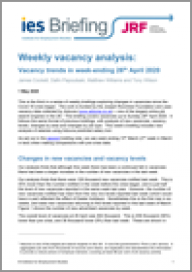Publications
 We author and publish a range of resources to keep you up to date with the latest developments in employment, labour market and human resource policy and practice.
We author and publish a range of resources to keep you up to date with the latest developments in employment, labour market and human resource policy and practice.
All our pdf publications are free to access.
Search results
-

Strategic HRM in Practice: Case Study
G’s Fresh Group and the Farm of the Future
Brown D | May 2020 | Institute for Employment StudiesThis is the latest case study in our Strategic HRM in Practice project which aims to research whether and how employers are making a strategic approach to people management a successful reality in today’s fast moving and challenging contexts.
-

Securing a place for young people in the nation’s economic recovery
May 2020 | Institute for Employment StudiesThe paper, written jointly by Youth Employment UK, the Youth Futures Foundations, Impetus, The Prince’s Trust and IES, sets out practical proposals to ensure that young people are supported during the current crisis and can share in the economic recovery.
-

Labour Market Statistics, May 2020: Analysis of Claimant Count data
Wilson T | May 2020 | Institute for Employment StudiesThis briefing note sets out analysis of the Claimant Count data published this morning (19 May). The Claimant Count is a measure of the number of people claiming benefits principally for the reason of being unemployed. The statistics released today relate to claimants as at 9 April 2020, so approximately three weeks after the Covid-19 crisis began.
-

Help Wanted: Getting Britain Back to Work
May 2020 | Institute for Employment StudiesThis paper has been written in collaboration between IES and a range of other organisations, experts and partners in employment and social policy. It sets out evidence- and practice-based proposals for the employment and labour market response to this crisis.
-

Weekly vacancy analysis: Vacancy trends in week-ending 10 May 2020
Wilson T, Cockett J, Gray H, Papoutsaki D, Williams M, | May 2020 | Institute for Employment StudiesThis is the fifth in a series of weekly briefings exploring changes in vacancies since the Covid-19 crisis began. This week's briefing includes analysis to Lower Tier Local Authority level and recommendations for government actions around employment support.
-

Development of an EU framework to assess the overall impacts of occupational health and safety (OSH) prevention on the performance of construction enterprises
Final Report
Ende M, Flickenschild M, Sapulete S, Howard A, Wilson S | May 2020 | European CommissionThis study developed an EU framework to assess the impacts of OSH prevention on the performance of construction enterprises.
-

Covid-19: Practical guidance for the HR professional
Griffin E | May 2020 | Institute for Employment StudiesA guide designed to help HR professionals navigate through the unprecedented challenges presented by the Covid-19 pandemic. Focused around three phases organisations may need to manage their responses – React, Recover and Renew.
-

Weekly vacancy analysis: Vacancy trends in week-ending 3 May 2020
Gray H, Cockett J, Papoutsaki D, Williams M, Wilson T, | May 2020 | Institute for Employment StudiesThis is the fourth in a series of weekly briefings exploring changes in vacancies since the Covid-19 crisis began. This week’s briefing includes new analysis of changes in vacancies by the productivity level of the local area.
-

Weekly vacancy analysis: Vacancy trends in week-ending 26 April 2020
Cockett J, Papoutsaki D, Williams M, Wilson T, | May 2020 | Institute for Employment StudiesThis is the third in a series of weekly briefings exploring changes in vacancies since the Covid-19 crisis began. This briefing covers vacancies up to Sunday 26 April 2020 and includes new analysis of the changes in vacancies by salary levels.
-

Weekly vacancy analysis: Vacancy trends in week-ending 19 April 2020
Papoutsaki D, Cockett J, Williams M, Wilson T, | Apr 2020 | Institute for Employment StudiesThis is the second in a series of weekly briefings exploring changes in vacancies since the Covid-19 crisis began. This briefing covers vacancies up to Sunday 19 April 2020 and includes new analysis of the ‘flow’ of new vacancies as well as changes in levels.
